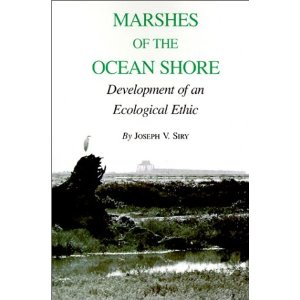 "A river is a unit from its source to its mouth." Ask any fish.
"A river is a unit from its source to its mouth." Ask any fish. The New Ecology and the New Ecological Ethic
 "A river is a unit from its source to its mouth." Ask any fish.
"A river is a unit from its source to its mouth." Ask any fish.
The "uncountable richness of diversity of our collective patrimony,"
this Canadian graphic explains about rivers, wetlands (etangs) & lakes (lacs) as public goods.

Rivers were so degraded by the 1850s though 1890s that many called for the enforcement of laws to protect access, use, and health.
Chapters | Overview | Notes | Review | Key Players | Significant Idea | Summary | book |
"At the turn of the century ecology and economics agreed on the classification of tidal marshes as obstructing wastelands. Resource economics determined the 'best' use of land solely from human and utilitarian perspectives. The initial findings of terrestrial and marine biologists supported policies to make human 'improvements' over nature's perceived inefficiency. However, in The 1930s and 1940s a number of scientists, including wildlife biologist, Aldo Leopold, would begin to demonstrate that The political and economic values assigned to coastal wetlands and other wild areas conflicted with their biological integrity."
Key Players
Aldo Leopold -- Marshland Elegy, Round River, beauty, health and biological integrity.
W. J. McGee -- Comprehensive planning of rivers and their watersheds
Raymond Lindeman -- Trophic or feeding levels in a Cedar Bog
Gunter Gordon -- Plankton and food chains of Gulf Coast fisheries
Steven Forbes -- the Lake as Microcosm
Lakes, like Lake Tahoe shown here are a small indicator of how human settlements can damage ecological systems if wetlands are destroyed.
Wetlands always were a national matter of concern for the impacts of land-use.
Review of Chapter Six's main points:
Aldo Leopold and the new ecology
A challenge to the Progressive consensus as wild seashores became expendableComprehensive Riverine ManagementProgressive triumph of suburbia as the "middle landscape"
Ability of science to understand and control the natural world
Tidelands Oil Controversy
state authority in tidal seas shared with federalComprehensive Riverine Management sustained by the courts in 1936,
TVA decision was a Federal stimulus to growth in coastal areas and a concomitant loss of wetlands because affordable energy and cheap water are keys to development.
A Growing ecological revolt against older political and scientific assumptions was evident among some professional scientists.
See revolt of nature as a philosophical shift underlying the ecological revolt.
Ecologically estuaries were shown to be the most productive biological communities.
Coastal wetlands are the more productive of any submerged landscape.
energy transfer and waste recycling of the New Ecology replaced older succession model –This meant that what was seen as a "natural" tendency for wetlands to fill and thus be considered as transitional landscapes to more permanent plant association was not entirely accurate. Instead–especially coastal wetlands–could be measured in terms of their extent and exposure to nutrients, radiation, tidal fluctuation and freshwater runoff.
When all these factors are considered like defining trophic levels and measuring the amount of food available at each level of energy transfer; surprising results were found.
A. G. Tansley's ecosystem model, developed in the 1930s, was a concept that was suited for one biome to be compared to another in respect to productivity. This advancement in ecological ideas meant that the amount of solar radiation per square area (acres or hectares) over time that is turned by bacteria and plants into matter–called biomass– is quantifiable. These are just the start of the functional focus that means water quality, available nutrients and changes in water levels can all be measured and linked to the performance of a particular kind of vegetative association.
Arthur George Tansley was a Cambridge biologist specializing in plants, especially plant ecology and he systematized terminology in used in ecology early in the 20th century.
page, 117.Tansley's work revealed the existence of an Energy Pyramid, which later Aldo Leopold turned into an essay in "Thinking Like a Mountain."
Ecology, diversity and food webs are all defined by the 1930s
Ecosystem logic and solar energy transformation into biomass
Three fold shift in emphasis:
His ideas and those of other biologists enlarged the concept of biological community.
The ecological revolt was a perspective advocated by naturalists, biologists and members of wealthy groups like Audubon, Sierra Club, and the Appalachian Mountain Club, whose stubborn refusal to accept ideas of progress that involved a loss of plants and animals because these people perceived that too many wildlife were going extinct.
They based their ideas on natural history museums and the idea of landscape as a microcosm. Especially ecotones we example of a small piece of terrain that revealed global truths.
Lake shore were on type of ecotone, the idea of place as small slice: Lake as Microcosm, Forbes
Forbes worked for the Illinois State Natural History SurveyCoastal studies led to a serious critique of one dimensional planning.
Lindeman's cedar bog lake study of energetics
Decomposition was a key retriever of material or biomass made by nature
Ecological functions
Energy dissipation and its challenge to ecology to overcome eventual decay and loss
Sverdrup's story of the oceans as retrievers of heat and regulators of climate.
The ecotone is where these lakeshore marshes turn into higher ground and dry land.
Aldo Leopold had come to view energy, land, and water forming an exploitable milieu but an asset that had to be nourished if it's natural wealth was not to be diminished.
 He had three stories with regard to marshes: The Delta Colorado, actually about jaguar hunting in Mexico's Gulf of California–in addition to "Marshland
Elegy" & Fable of Round River .
He had three stories with regard to marshes: The Delta Colorado, actually about jaguar hunting in Mexico's Gulf of California–in addition to "Marshland
Elegy" & Fable of Round River .
Seeing in a smaller piece, such as a salt marsh, wetland, lake, bog, or estuary, the larger (macro) functions.
Hence, the smaller unit or microcosm, is a model that informs us about the whole, larger macrocosm.
Land, when viewed as a circuit of transferred solar energy or tidal power is really a milieu of water, energy air and land forming productive landscape with ample vegetation for more wildlife.
page, 122.
Coevolution of plant and animal life means that certain dependent relationships occur where predators and prey evolve together with their surrounding conditions.
The whole landscape is important as more than the sum of its constituent parts.
Progressive utilitarianism was challenged.eliminating whole elements of the biocenose that lack value, or economic payoff
Narrow calculations of economic utility were no longer sufficient to understand land-use.
There is an irony of farm reclamation during the agricultural recession and Great Depression.
page, 123.Six hydrological consequences of removing wetlands
Wetlands, far from being wastelands were seen as needed nutritional elements in the watershed.
- reduced groundwater percolation or recharge of water sinking into underground aquifers.
- subsidence of drained land from soil compaction and interstitial water loss.
- increased downstream flooding.
- changes in the velocity of water across the streambed and movement of silt downstream.
- increase in the amount of nutrient (nitrogen and phosphorus) in lakes and streams.
page, 124.
Loss of biological diversity due to economic conversion of marshes was due to a loss of native vegetation and the solitude marshes provided that were appreciated only by ornithologists and cranes.
Marshes have a paleontologic patent of nobility because Cranes have evolved together with these valuable habitats and they need one another to prosper in the future.
But --in contrast-- the language of progressive conservation was adversarial, man vs. nature.
There is a need to be sustaining the "bio-energetic integrity of ecosystems."
page, 126.
Fable of Round River
pipeline of energy leaks in the circuit of energy that is the land.
plants as producers of food and nutrition for consumers
Land as "a maze of services and competitions, of piracies and cooperations."
coevolutionlandscape possesses biological integrity
Round river was a story from Paul Bunyan about a fabled river that flowed into itself in a never ending, revolving fund of decay and renewal.
page, 126.
"Marshland Elegy"Who could afford Leopold's ethics?
Sand hill cranes need marshes.
We are all just a separate cog in an ecological mechanism
TVA , saw rivers as valuable for what they transport, falling water.
Flood Control was the preeminent reason for federal interest in Comprehensive Riverine Management.
Conservation as a means of relegating costly actions to government will fail
Leopold's ecological credo required protection of all parts of the ecosystem.
discovery of the complexity of the land mechanism, is the great achievement of this century.
marginal value of land runs counter to ecological values.
Local government dependence on property taxes [the ad valorem taxation approach of many states] works to destroy marshes.
ad valorem taxation is based on the premise that taxes are levied on the highest and best use for the property.
"Land-use ethics is still dominated by economic self-interest."
Leopold quoted obscure Biblical scripture to foster a new perspective based on older, ancient values:
The Biblical Books of Ezekiel & Isaiah
"I am glad I shall never be young without wild country to be young in."
The mud flats amidst marshes of the Weeki Wachee RIver, Florida.
page, 133.
When pink shrimp, clams, lobsters, salmon, crabs, or other estuarine dependent food fisheries are considered, the conclusion Odum and others reached is that the acre of a coastal marshland is more productive than a cornfield and its food products may be as valuable per unit of solar radiation falling on a square meter of wetland as any cattle, sheep, or dry meadow.
"islands of diversity amidst a sea of sameness... meant a dedication to landscape renewal."
Political protection lagged behind development
Chapters | Overview | Notes | Review | Key Players | Significant Idea | Summary | book | value of estuaries
Siry  Book overview : Chapters 1, 2, 3, 4, 5, 6, 7, 8, 9,
Book overview : Chapters 1, 2, 3, 4, 5, 6, 7, 8, 9,